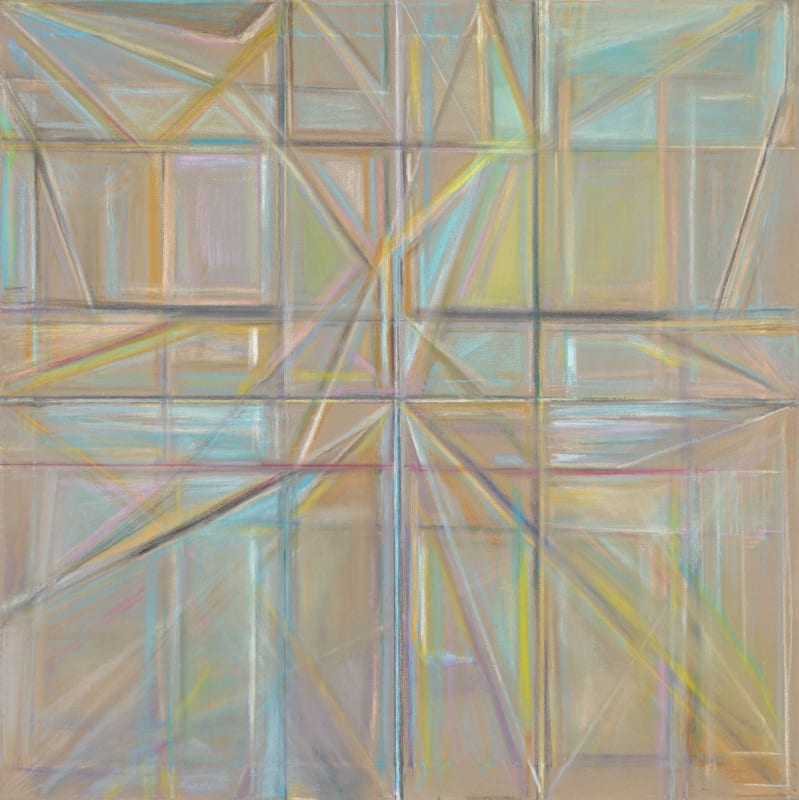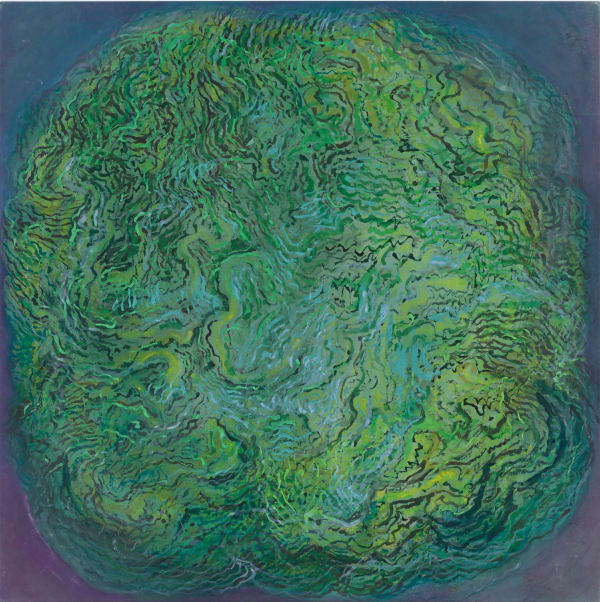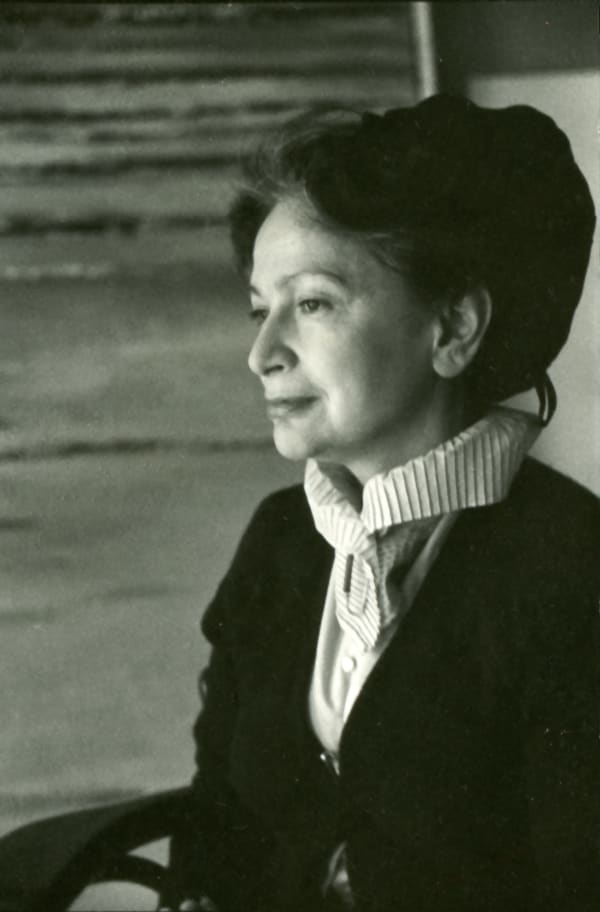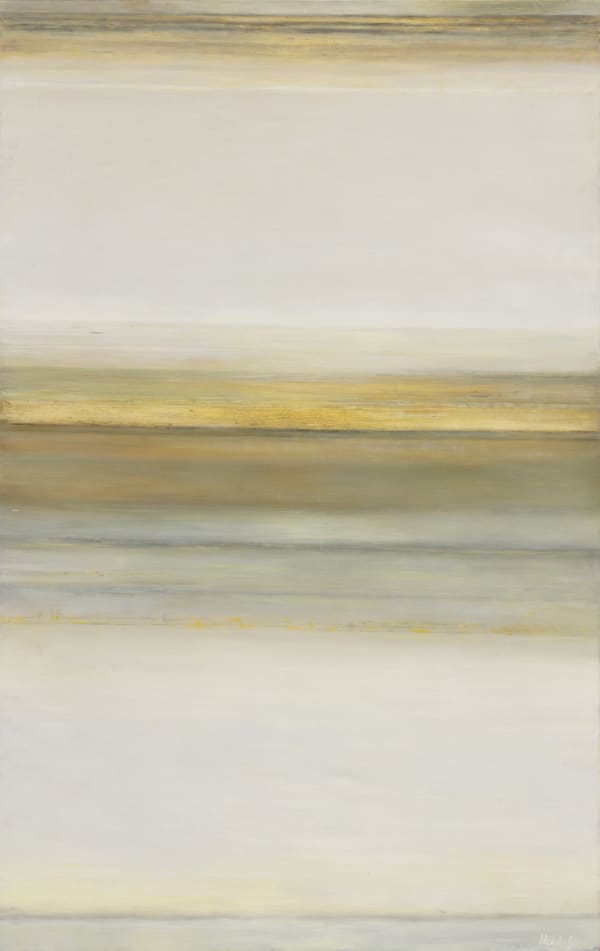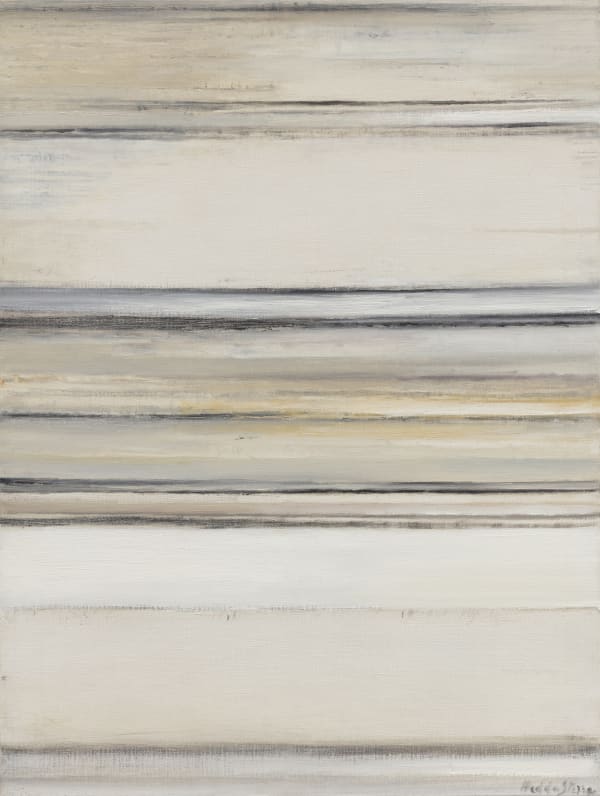Hedda Sterne
-
About
An active member of the New York School, Hedda Sterne, who was born in Bucharest, Romania in 1910 and fled to the US in 1941, created an extensive body of work that intersected with some of the most important movements and figures of the twentieth century. A bridge between European Modernism, in particular Surrealism, and American Abstract Expressionism, Sterne's work stands as a testament to her independence of thought, moving freely between figuration and abstraction throughout her long career. Sterne stated, 'I believe… that isms and other classifications are misleading and diminishing. What entrances me in art is what cannot be entrapped in words.'
Early international recognition came when collages included in a Paris exhibition in 1938 were singled out for praise by Jean Arp. Through him, Sterne was recommended to Peggy Guggenheim, and was later included in five exhibitions at Guggenheim's Art of This Century gallery in New York. Embraced by fellow Surrealist exiles in the city, Sterne was also included in the exhibition First Papers of Surrealism in 1942, organised by André Breton and Marcel Duchamp. While her first works completed in the US retain the influence of Surrealism, Sterne quickly absorbed the spirit of the metropolis, drawing inspiration from its architecture, its scale and dynamism. Industrial forms such as farm machinery start to appear in her work of the 1940s following a visit to Vermont with her second husband, fellow artist and Romanian émigré Saul Steinberg, whom she married in 1944.
By the 1950s, Sterne was increasingly concerned with motion and light, combining formal innovation with material experimentation in her use of commercial aerosol spray paint in her attempt to interpret the increasing speed of the world around her. Looser and increasingly atmospheric, works from this period are characterised by a sense of mergence - of manmade and organic forms becoming as one. Sterne is widely remembered for her appearance at this time in a now iconic photograph for Life magazine, published in 1951, of the 'Irascibles' - a group of artists who protested against the Metropolitan Museum of Art's failure to reflect contemporary abstraction in its exhibitions of American art. Notably, she is the only woman in the image. Sterne would later comment that 'I am known more for that darn photo than for eighty years of work.'
The 1960s were an especially productive decade for Sterne, her work becoming increasingly abstract, minimal and experimental as the decade progressed, while also drawing clear inspiration from natural phenomena and elements of landscape. During this period Sterne began meditating daily, a practice that would have a profound effect on her life and work. In 1961, she spent time at Yaddo as an artist in residence, and in 1963, she travelled to Venice, where she would live and work as a Fulbright fellow until the summer of 1964. Shortly after her return to the US, she purchased a property in the East Hampton Springs community, which became her summer home and studio for several decades, and where she was able to work on ever larger canvases, and experiment in profoundly new ways.
Sterne's final artist's statement, composed in 2004, articulates what she felt to be a primary achievement of her life in art: 'With time, I have learned to lose my identity while drawing and to act simply like a conduit, permitting visions that want to take shape to do so.' She died in New York in 2011 at the age of 100.
-
Biography
Hedda Sterne was born in Bucharest, Romania in 1910. She was a part of the city’s thriving avant-garde community during the interwar period and was mentored by Dada co-founder Marcel Janco and Surrealist Victor Brauner.
Between 1927 and 1932 she travelled frequently to Vienna and Paris, where she attended classes in the ateliers of André Lhote and Fernand Léger, and at the Académie de la Grande Chaumière. She studied art history and philosophy at the University of Bucharest from 1929 to 1932. That year, she married Friederich (Fritz) Stern, and during the following decade continued her artist practice while travelling between Bucharest and Paris. In 1938 she was included in the 11th annual Salon des Surindépendants, where her collages draw the attention of Jean Arp and Peggy Guggenheim.
Returning to her family in Bucharest in the lead up to World War II in 1939, Sterne witnessed the Romanian Iron Guard Revolt and Bucharest Pogrom in 1941. Later that year, she was able to travel to Lisbon and from there to New York, where she joined her husband who had left Romania on a business visa in 1940. Sterne established a studio on East 50th Street in 1942, becoming close friends with her neighbours Peggy Guggenheim and Max Ernst. Through Guggenheim she was introduced to artists including Piet Mondrian, André Breton and Marcel Duchamp. Breton and Duchamp included Sterne in the 1942 exhibition First Papers of Surrealism, Sterne’s first group exhibition in the United States.
In 1943, Peggy Guggenheim began to exhibit Sterne’s work at the Art of This Century gallery. That year, she also met Betty Parsons, who would become her long-time gallerist and close friend, and the artist and fellow Romanian émigré Saul Steinberg, who was commissioned as an ensign in the US Naval Reserve and soon departed on active duty. They corresponded regularly over the following year.In the summer of 1944, Sterne’s divorce from Fritz Stafford was finalised. (Fritz and Hedda had changed their German-sounding surname from Stern to Stafford in 1941, though since she had been building her career with her original married name, she soon began to exhibit her work as Hedda Sterne, a nom de plume through the addition of an ‘e’). She married Steinberg in October 1944. While the pair separated in 1960, they were never divorced.
Sterne’s first solo exhibition in the US took place in 1943, organised by Betty Parsons at the Wakefield Gallery. When Parsons opened her own gallery in 1946, Sterne was one of 16 artists represented by the pioneering gallery at its founding, along with Mark Rothko, Barnett Newman and Ad Reinhardt. In 1950, Sterne was named one of the country’s best artists under the age of 36 by Life magazine and that year was one of 28 artists to sign an open letter to the president of the Metropolitan Museum of Art, protesting the museum’s aesthetically conservative group exhibition juries. Life magazine published an article about the letter in a January 1951 issue. Sterne was among 15 of the signatories photographed by Nina Leen for the article. The image, subtitled ‘Irascible Group of Advanced Artists’ includes, among others, Barnett Newman, Mark Rothko, Jackson Pollock, Clyfford Still, Robert Motherwell, Willem De Kooning, Adolph Gottlieb, Ad Reinhardt. Sterne, the only woman, can be seen standing on a table at the very top. The photograph is one of the defining images of the New York School.
In 1963, awarded a Fulbright fellowship in painting, Sterne lived and work for over a year in Venice, where she developed her Vertical-Horizontals. She began a daily practice of meditation in 1966, which became important for the rest of her life. Sterne continued to make paintings, drawings and prints, exhibiting widely through to the 2000s. She died in New York in 2011 at the age of 100.
Retrospective exhibitions have been mounted at the Montclair Art Museum, New Jersey in 1977 and at the Queens Museum in Flushing Meadow, New York in 1985. Hedda Sterne: Dessins (1939–1998), a retrospective of drawings, was held at Bibliothèque Municipale, Ville de Caen, in 1998. Uninterrupted Flux: Hedda Sterne, A Retrospective was held at the Krannert Art Museum, University of Illinois at Urbana-Champaign in 2006, touring in 2007 to the University of Virginia Art Museum, Charlottesville, Virginia. Sterne’s work has enjoyed increased critical visibility in recent years, featuring in major group exhibitions and museum displays, such as The Form of Freedom: International Abstraction after1945 at Museum Barberini, Potsdam (4 June–25 September 2022); Midcentury Abstraction: A Closer Look at the Yale University Art Gallery (2022); Elles font l’abstraction at Centre Pompidou, Paris (2021); Labyrinth of Forms: Women and Abstraction, 1930-1950 at the Whitney Museum of American Art, NY (2021-22); Affinities for Abstraction: Women Artists on Eastern Long Island, 1950–2020, at Parrish Art Museum, NY (2021); Epic Abstraction: Pollock to Herrera at The Met Fifth Avenue, NY (2018–20); Hedda Sterne: Printed Variations at Amon Carter Museum of American Art, TX (2018-19); Making Space: Women Artists and Postwar Abstraction at MoMA, NY (2017). A solo exhibition was held at Victoria Miro in London in 2020.
Her works are represented in major international collections including The Art Institute of Chicago, Carnegie Museum of Art, Pittsburgh, the National Gallery of Art, and the Smithsonian American Art Museum, Washington, D.C., The Metropolitan Museum of Art, Whitney Museum of American Art and the Museum of Modern Art, New York, Musée National d’Art Moderne, Centre Pompidou, Paris, France, and Tate, UK.
-
News
-

Beyond Form: Lines of Abstraction, 1950–1970, featuring Hedda Sterne, at Turner Contemporary
January 23, 2024Curated by Dr Flavia Frigeri, the exhibition (3 February–6 May 2024) brings together the works of more than 50 artists to examine how, through abstract...Read More -

Artnet profiles Hedda Sterne
November 2, 2022‘I’ll Have Terrific Shows Posthumously,’ Hedda Sterne Said. She Was Right—and Now the Late Artist Is Getting the Recognition She Deserved By Karen Chernick If...Read More -

The Financial Times reports on Victoria Miro’s representation of Hedda Sterne
September 15, 2022‘After a sellout solo exhibition of work by Hedda Sterne in 2020, London’s Victoria Miro gallery now represents the estate of the New York School artist, alongside Van Doren Waxter in the US.’Read More -

Announcing representation of Hedda Sterne
September 15, 2022Victoria Miro is delighted to announce representation of Hedda Sterne (1910–2011) in partnership with The Hedda Sterne Foundation. Works by the artist will feature in...Read More -

Hedda Sterne is featured in Laura Cumming’s ten best of 2020
December 27, 2020‘Small but perfect show of this still bizarrely underrated American abstract painter: liquid, subtle and luminous visions of land and water that have lingered in...Read More -

★★★★★ Laura Cumming reviews Hedda Sterne in The Observer
February 2, 2020Hedda Sterne (1910-2011) is a magnificent heroine of art. She died in New York at the age of 100, almost entirely blind, but still drawing...Read More -

The Telegraph profiles Hedda Sterne
January 27, 2020'Hedda Sterne rejected the macho art world of the Fifties. Lucy Davies salutes an uncompromising talent.'Read More -

Jackie Wullschläger selects Hedda Sterne for the FT’s Critics’ Choice
January 25, 2020‘Motion and lights were always Sterne's subjects; now the sense of speed animating her "New York" paintings yielded to the meditative, impressive series Vertical-Horizontals, featuring luminous striated lines and quivering uneven bands. They are the focus of this first UK show…’Read More
-
-
Gallery Exhibitions
-

Hedda Sterne: Metamorphoses
5 Nov – 10 Dec 2022 VeniceThis exhibition features works drawn from the late 1960s and early 1970s, including important paintings from 1967 created by pouring thinned acrylic paint on to raw canvas.Learn More -

Hedda Sterne
29 Jan – 14 Mar 2020 Victoria Miro MayfairVictoria Miro presents the first UK solo exhibition of works by Hedda Sterne (1910–2011).Learn More -

Surface Work
11 Apr – 16 Jun 2018 Victoria Miro MayfairThis international, cross-generational exhibition is a celebration of women artists who have shaped and transformed, and continue to influence and expand, the language and definition of abstract painting. The exhibition...Learn More
-
-
Contact Form
Contact us regarding available works by Hedda Sterne
